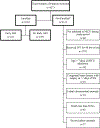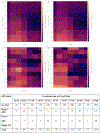Neonatal nephrotoxic medication exposure and early acute kidney injury: results from the AWAKEN study
- PMID: 37100984
- PMCID: PMC10725773
- DOI: 10.1038/s41372-023-01684-7
Neonatal nephrotoxic medication exposure and early acute kidney injury: results from the AWAKEN study
Abstract
Background: We aimed to describe nephrotoxic medication exposure and investigate associations between exposure and acute kidney injury (AKI) in the neonatal intensive care unit during the first postnatal week.
Design/methods: Secondary analysis of the AWAKEN cohort. We evaluated nephrotoxic medication exposure during the first postnatal week and associations with AKI using time-varying Cox proportional hazard regressions models. Nephrotoxic medication exposure categories were defined as: no nephrotoxic medication, nephrotoxic medications excluding aminoglycosides, aminoglycoside alone, and aminoglycoside and another nephrotoxic medication.
Results: Of 2162 neonates, 1616 (74.7%) received ≥1 nephrotoxic medication. Aminoglycoside receipt was most common (72%). AKI developed in 211(9.8%) neonates and was associated with a nephrotoxic medication exposure (p < 0.01). Nephrotoxic medication exposures including a nephrotoxic medication excluding aminoglycoside (aHR 3.14, 95% CI 1.31-7.55) and aminoglycoside and another nephrotoxic medication (aHR 4.79, 95% CI 2.19-10.50) were independently associated with AKI and severe AKI (stage 2/3), respectively.
Conclusions: Nephrotoxic medication exposure in critically ill infants is common during the first postnatal week. Specific nephrotoxic medication exposure, principally aminoglycosides with another nephrotoxic medication, are independently associated with early AKI.
© 2023. The Author(s), under exclusive licence to Springer Nature America, Inc.
Conflict of interest statement
DJA is a consultant for Baxter, Nuwellis, Bioporto, and Seastar. His institution receives grant funding for education and research that is not related to this project from NIH, Baxter, Nuwellis, Medtronic, Bioporto, Portero, and Seastar. He has patents pending on inventions to improve the kidney care of neonates. He is the Founder and Chief Scientific Officer for Zorro-Flow Inc.
HJS received research grants with Baxter. No other disclosures were reported.
KG is a consultant for Bioporto and Potrero Medical.
JRC is on the Executive Board for the Neonatal Kidney Collaborative, a consultant for Medtronics, and an investor in Zorro-Flow.
Figures


References
-
- Arcinue R, Kantak A, Elkhwad M. Acute kidney injury in ELBW infants (< 750 grams) and its associated risk factors. J Neonatal Perinatal Med 2015, 8(4): 349–357. - PubMed
-
- Beken S, Akbulut BB, Albayrak E, Güner B, Ünlü Y, Temur B, et al. Evaluation of neonatal acute kidney injury after critical congenital heart disease surgery. Pediatr Nephrol 2021, 36(7): 1923–1929. - PubMed
-
- Criss CN, Selewski DT, Sunkara B, Gish JS, Hsieh L, McLeod JS, et al. Acute kidney injury in necrotizing enterocolitis predicts mortality. Pediatr Nephrol 2018, 33(3): 503–510. - PubMed
Publication types
MeSH terms
Substances
Grants and funding
LinkOut - more resources
Full Text Sources

